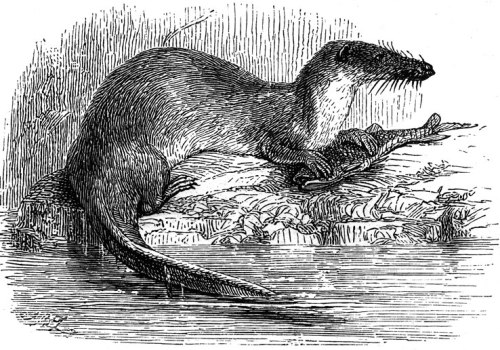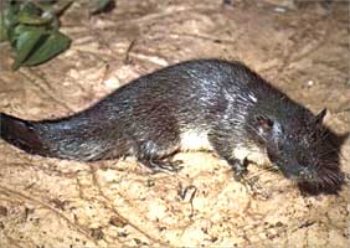
August 5, 2007


There are three known kinds of electric – more correctly called electrogenic – animals:
(1) the one species, Electrophorus electricus, of South American electric eel (really a knifefish),
(2) the 19 species of African electric catfish in the genera Malapterurus and Paradoxoglanis, and
(3) the 69 species of electric rays (order Torpediniformes) found around the world.
The first two fish both demonstrate the ability to shock prey with electricity as an effective strategy for a piscivore (an animal that eats fish). They produce high levels of voltage, e.g. electric eel (600 volts) and the electric catfish (350 volts). Electric rays can produce an electric discharge used to stun or kill prey, from as little as 8 volts to up to 220 volts depending on the species.
Could there be an electrogenic mammal?

The range of Potamogale velox (pictured at the top) is limited to western central Africa, where this story opens.
I recently received news from a zoologist detailing just such a possibility:
I have spent a lot time in Central Africa collecting. I have repeatedly heard stories from locals in Gabon about a cat-sized mammal that gets caught in fisherman’s gill nets that delivers a powerful electric shock…one worse, reportedly than that given by the common electric catfish.
Initially I was puzzled about the identity of the mammal they were talking about, but at some point realized it had to be Potamogale velox, the giant otter “shrew” (actually a tenrec) which is common in this area. I have pulled drowned individuals from my traps on two occasions, but have not examined them for an electric organ. Next time I get the chance, I will.
Potamogale velox is called the “giant otter shrew” but it is not technically a shrew. Shrews belong to family Soricidae while Potamogale velox is a tenrec (Family Tenrecidae). Both families were once placed into the mammal order Insectivora, but Insectivora allegedly is no longer recognized as a natural group.
Of course, a live one would be more interesting. Apparently they die quickly in captivity. I thought I’d pass this along to you in case you [or your readers] have heard other similar accounts.
There are no known electrogenic mammals, i.e. mammals which have electric organs that produce electric discharges. The platypus may be the only mammal that has an electrosensory system and can perceive the weak bioelectric field that surrounds its prey. If (and it is a big IF) the giant otter shrew is electrogenic, it would be a first and would be a zoological discovery of huge proportions.
I’ve heard the electrogenic mammal story on at least three occasions at three different [central African] localities, usually after a brief discussion or encounter with an electric catfish. “Oh, that is nothing,” they will say, “compared to getting a shock from a [not understood, unfamiliar name for the creature].”
One place I remember hearing this story very clearly is on the shore of Lac Zilé near Lambaréné in Gabon.
Maybe someone else will see this and chime in with more info. If someone who is interested in sponsoring a trip to Gabon to collect this beast, feel free to refer them to me.Zoologist, name on file, who works in a sensitive employment location where talk of cryptids would perhaps not be appreciated.
It looks like there’s a new cryptid to add to all our lists.
Is Potamogale velox the answer to this new mystery or is it a new species?
About Loren Coleman
Loren Coleman is one of the world’s leading cryptozoologists, some say “the” leading living cryptozoologist. Certainly, he is acknowledged as the current living American researcher and writer who has most popularized cryptozoology in the late 20th and early 21st centuries.
Starting his fieldwork and investigations in 1960, after traveling and trekking extensively in pursuit of cryptozoological mysteries, Coleman began writing to share his experiences in 1969. An honorary member of Ivan T. Sanderson’s Society for the Investigation of the Unexplained in the 1970s, Coleman has been bestowed with similar honorary memberships of the North Idaho College Cryptozoology Club in 1983, and in subsequent years, that of the British Columbia Scientific Cryptozoology Club, CryptoSafari International, and other international organizations. He was also a Life Member and Benefactor of the International Society of Cryptozoology (now-defunct).
Loren Coleman’s daily blog, as a member of the Cryptomundo Team, served as an ongoing avenue of communication for the ever-growing body of cryptozoo news from 2005 through 2013. He returned as an infrequent contributor beginning Halloween week of 2015.
Coleman is the founder in 2003, and current director of the International Cryptozoology Museum in Portland, Maine.
Filed under Breaking News, Cryptomundo Exclusive, Cryptotourism, CryptoZoo News, Cryptozoologists, Cryptozoology, Expedition Reports, Eyewitness Accounts, Folklore, New Species